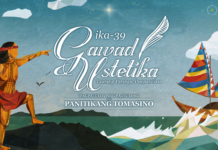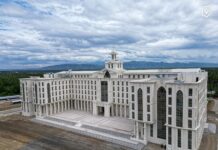DEVIATING from traditional methods of training, the University is making a big leap into the technological world by offering the long-awaited non-military components of the National Service Training Program (NSTP)—the Civic Welfare Training Service (CWTS) and Literacy Training Service (LTS)—online.
Unlike other schools, UST is the only university in the country to use an interactive approach on the CWTS and LTS, the non-military proponents of the NSTP.
The innovation is another first from UST, which led the University Belt Consortium in 2001 in an extraordinary call to abolish the compulsory Reserved Officer’s Training Corps (Rotc) program. The call came after the murder of UST Engineering student and Rotc cadet Mark Chua after he exposed corruption in the ROTC.
As a result of the call, President Macapagal certified a bill and Congress passed a law creating the National Service Training Program, which made Rotc non-compulsory and offered civilian programs in place of ROTC.
E-Leap
Through the Electronic Learning Access Program or e-Leap, Thomasians can access their lessons online. Aimed at integrating the Information Communication Technology (ICT) into the teaching and learning process in the University, the new program is an initiative of the UST Educational Technology Center (Ed-Tech). With it, UST cadets need not be on campus to receive their lessons.
According to LTS coordinator and College of Education professor Marilyn Quintana, the University opted to use e-learning to compensate for the lack of personnel. “We are expecting 5,000 enrollees,” she said.
Faculty of Pharmacy professor Ninia Inoncillo-Calaca, E-leap project manager, said that with the program, module facilitators can just post their announcements, lectures, and assignments. Students would just log-in to verify examination results or e-mail their instructors for questions and clarifications.
According to Office for Student Affairs director Dr. Evelyn Songco, UST-NSTP coordinator, the sophomores will be given the option to enroll in CWTS or LTS because “they are more mature.”
The choice of having CWTS and LTS will be given only to second-year students because the program needs a little more maturity when they are tasked to go to the community,” Songco explained. “Sophomores are more or less adjusted to the environment in the city.”
Enrollees in the CWTS and the LTS programs will attend only three sessions on campus—the orientation, the preliminary exams, and the finals. The rest of the lessons can be accessed through the Internet.
Both programs will contain the same course syllabus dealing with foundations of community service, the principles in community organization, national issues and concerns, case studies of community and concepts of people empowerment, as well as the principles of effective teaching and learning.
However, e-learning will only be implemented in the first semester.
The second semester will give Thomasians the opportunity to apply what they have learned. They will be given time to analyze government and non-government community projects. Both semester will be equivalent to 54 work hours per subject.
Domingo said one of the eight modules will acquaint CWTS students with social issues—on the elderly, the environment, and disaster preparedness.
CWTS students will take a pre-test before the lesson proper and a post-test to evaluate their performance.
Quintana said the purpose of LTS is to produce individuals who can later on serve the country through teaching. LTS aims to give students vital information on professional teaching and education.
Quintana told the Varsitarian they would coordinate with the Education High School and other institutions affiliated with UST where LTS enrollees can apply what they have learned.
She added that the LTS cadets can also use their “teaching” skills at Sitio Malasa, Tarlac, where the University has a distance learning center.
“I hope that through this program, we can create a lot of teachers but through this program, we can include students from other colleges,” Quintana said.
Competition with military program?
In spite of all the preparations being made, CWTS coordinator Rowena Castro said the UST administration is apprehensive about the results of the new method.
“I do not know if it would motivate student because we are using the computer,” Castro added. “It is the first time that we are trying to send out our lectures on the Internet so we will see which is more effective, is it the person or the computer?”
Castro admitted that the new method might attract more students to choose CWTS or LTS over the Military Training Service (MTS). However, Castro said there is no competition among the components because UST is only following the law.
Department of Military Science and Tactics (DMST) assistant commandant Staff Sgt. Christopher Chua said nothing compares to the practical exercises taught in the MTS component of the NSTP. According to him, the use of the Internet may encourage irresponsibility.
“Katamaran ‘yun. Matuto silang maging tamad,” he said.
“Puwedeng mandaya sila diyan. Puwede silang magpagawa sa iba,” DMST Tactical non-commissioned officer Army Staff Sgt. Ricardo Manuel agreed.
Unfair?
Even before it is implemented, the new method of the NSTP’s non-military components has elicited mixed reactions from the students.
Rosalyn Mary Querida, an incoming AB-BSE sophomore who took the MTS component last year, said it is unfair.
“We were required to go to UST every Sunday at 7 a.m. Pag na-late kami, pinaparusahan kami. Hindi naman makatarungan iyun (the new CWTS and LTS methods),” she said.
Marian Christine Josephine Dalangin, however, is not at all sorry about taking the military component.
“Hindi ko pinagsisisihan ang pagkuha ko ng MTS. May natutunan din ako kahit papaano,” Dalangin said.
For incoming Political Science sophomore Peter Filler, the effectivity of the e-learning method depends on the students.
Despite the nearing implementation of the CWTS and LTS through e-learning there are still questions regarding the efficiency of the entire system. Critics are still wondering if the NSTP Law (Republic Act (RA) No. 9163 will live up to its goal¾to motivate, train, organize, and mobilize the youth in literacy and civic welfare service of the nation—or if it will just carry on the ghost of the old Reserve Officers Training Corps Law (RA 7077).
The new school year may yet provide answers. Rupert Roniel T. Laxamana III











Great Article! about military program